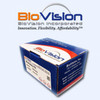Description
cIAP-2/HIAP-1 Antibodyis available at Gentaur for Next week Delivery.
Description: Apoptosis can be inhibited by a group of proteins called inhibitors of apoptosis (IAPs). These proteins contain a BIR (baculovirus IAP repeat) domain near the amino-terminus. The BIR domain can bind some caspases. Many members of the IAP family of proteins block proteolytic activation of caspase-3 and –7. For example, XIAP, cIAP-1 and cIAP-2 appear to block cytochrome c-induced activation of caspase-9, thereby preventing initiation of the caspase cascade. Since cIAP-1 and cIAP-2 were first identified as components in the cytosolic death domain-induced complex associated with the TNF family of receptors, they may inhibit apoptosis by additional mechanisms.
Immunogen Sequence:Synthetic peptide surrounding amino acid 510 of human cIAP-2
Target Alternative Name:CIAP2 , cIAP2 , IAP1, AIP1, HIAP-1, HIAP1, API2, C-IAP2 , hiap-1, HAIP1, MIHC, MALT2, BIRC3
Species Reactivities:Human, mouse, rat
Tag Line:/
Formulation:30 µg (0.2 mg/ml) affinity purified rabbit anti-cIAP-2 polyclonal antibody in phosphate buffered saline (PBS), pH 7.2, containing 30% glycerol, 0.5% BSA, 0.01% thimerosal.
Purification: Affinity purified
Application:Western blot, Immunohistochemistry
Positive Control:/
Application And Usages:Western blot analysis (0.5-4 µg/ml). However, the optimal conditions should be determined individually. Jurkat cell lysate can be used as a positive control.
Handling:The antibody solution should be gently mixed before use.
Additional Information
Size: |
30 µg |
Antibody Target: |
cIAP-2/HIAP-1 |
Category: |
cIAP |
Lot Number: |
50981 |
Host: |
Rabbit |
Antibody Type: |
Polyclonal |
Isotype: |
Rabbit IgG |
Accession Number: |
Q13489 |
Gene Id: |
330 |
Concentration: |
0.2 mg/ml |
Appearance: |
Colorless liquid |
Form: |
Liquid |
Storage Condition: |
-20 °C |
Shipping Condition: |
gel pack |
Shelf Life: |
12 months |
Country of Animal Origin: |
China |
Country of Manufacture: |
USA |
Usage: |
For Research Use Only! Not to be used in humans. |
Western Blot Verified: |
Verified |
Immunocytochemistry Verified: |
Not Verified |
Immunofluorescence Verified: |
Not Verified |
Immunoprecipitation Verified: |
Not Verified |
ELISA Verified: |
Not Verified |
ChIP Verified: |
Not Verified |
Flow Cytometry Verified: |
Not Verified |









